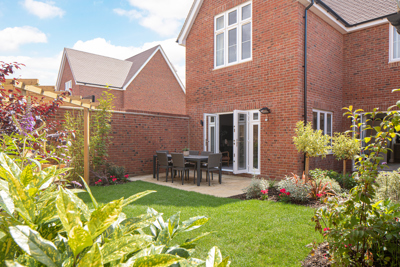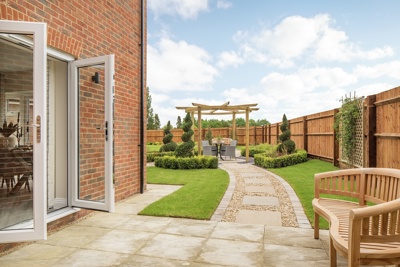Cala's Urban Wildlife Strategy outlines the intention to incorporate biodiversity improvement measures into every new home. One way we can encourage bees to pollinate is by making our gardens as bee-friendly as possible.
The Bumblebee Bee Conservation Trust is a hive of knowledge when it comes to bee-friendly gardens, so here are some top tips from their experts to make sure you are gardening with bees in mind…

No garden is too small
Whether you have a window box, allotment or large garden, planting bee-friendly flowers can help boost your local bumblebee population. In return, they will pollinate our flowers, crops, fruits and vegetables. No matter what size garden you have, you can do your bit for bumblebees by planting at least two kinds of bee-friendly flower for every flowering period (spring, summer, autumn).

Play to your garden’s strengths
The first thing to consider when designing your bee-friendly garden is the type of space you already have – is it sunny or shady, does it have trees, what about lawns or ponds? Research which flowers will flourish in the conditions your garden has and consider herbs too if you have a nice sunny spot – bees love their fragrant, flowery tops. Hedges can be great nesting spots, and even plants you’d consider ‘weeds’ can be great for bumblebees, so don’t be too hasty when getting rid of them!

Go wild
If you’ve got enough space in your garden, or have access to an area within your local community, why not create a wildflower meadow to provide bumblebees with food and shelter throughout their active season (March-October)?
Choose your flower power carefully
Certain plants have flower shapes that bumblebees cannot use. For example, some flowers have petals that form long tunnels which are too long or narrow for the bees to feed from. Similarly, flowers with multiple tightly packed heads offer bees very little accessible food. Others might produce little or no pollen and nectar, for example plants like pansies and double begonias offer little for bumblebees and other pollinators. This guide can help you choose the right plants.

Say ‘buzz off’ to chemicals
Try to avoid using any pesticides in your garden. They are often labelled as 'bug killers' or something similar, but almost all of these can harm bumblebees, even if you don't intend to harm them. Some pests can be controlled by simply planting certain other plants nearby.

Bee budget friendly
Bee-friendly gardening can be enjoyed on any budget. Seed packets can be much cheaper than buying established plants, and a growing number of online shops sell trays of plug plants, including both garden favourites and wildflowers. You will often need to wait a year until they flower, but this is a cost-effective option. Many bee-friendly plants can be split at the roots or take well from cuttings, so have a think about what plants might already be accessible to you – a great way to save the pennies.

Get everyone involved
Gardening is for everyone, so get the kids involved, your friends, neighbours and local community and start growing a haven for bumblebees!

For more tips on how to make your garden more sustainable, read our guide to going green in your garden or check out our tips for helping wildlife and plant life to flourish in your garden.
We’re on an exciting journey to dramatically transform our business and embed a culture of sustainability in everything we do.
Visit our Sustainability page to view the work we are doing as a business to reach our goal of becoming operationally net-zero carbon enabled.
Share your gardening efforts and any more bee tips with us on Instagram @calahomes.





